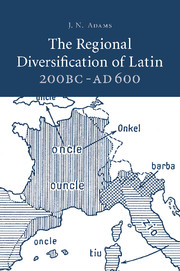Book contents
- Frontmatter
- Contents
- List of maps
- Preface
- List of abbreviations
- Chapter I Introduction
- Chapter II The Republic: inscriptions
- Chapter III Explicit evidence for regional variation: the Republic
- Chapter IV Explicit evidence: the Empire
- Chapter V Regionalisms in provincial texts: Gaul
- Chapter VI Spain
- Chapter VII Italy
- Chapter VIII Africa
- Chapter IX Britain
- Chapter X Inscriptions
- Chapter XI Conclusion
- Maps
- Bibliography
- Index verborum
- Subject index
- Index locorum
Chapter VII - Italy
Published online by Cambridge University Press: 22 September 2009
- Frontmatter
- Contents
- List of maps
- Preface
- List of abbreviations
- Chapter I Introduction
- Chapter II The Republic: inscriptions
- Chapter III Explicit evidence for regional variation: the Republic
- Chapter IV Explicit evidence: the Empire
- Chapter V Regionalisms in provincial texts: Gaul
- Chapter VI Spain
- Chapter VII Italy
- Chapter VIII Africa
- Chapter IX Britain
- Chapter X Inscriptions
- Chapter XI Conclusion
- Maps
- Bibliography
- Index verborum
- Subject index
- Index locorum
Summary
INTRODUCTION
There is evidence from an early period pointing to regional variation in the Latin of Italy, much of which has been discussed in chapters II–IV. I concentrate in this chapter on textual evidence, but also comment briefly on Pompeian graffiti. Italian inscriptions will come up again in Chapter X. A comprehensive study of all the texts written in Italy would be out of the question, and I have had to be selective. Texts that might be expected to show a regional flavour include the fragments of Atellan farce (but for farce the best evidence is metalinguistic: see III.6.1), the Cena Trimalchionis of Petronius and curse tablets. Varro was from outside Rome and not averse from admitting non-standard usages. Virgil himself wrote on country life. In the late period there is a corpus of medical texts (translated from Greek originals) now conventionally attributed to Ravenna, and these provide material for a case study concerning the question whether and on what criteria the provenance of a late text might be identified. I have treated the ‘Ravenna school’ as a subject of study in its own right, and this occupies a good part of the chapter, but some principles relevant to the themes of this book will emerge.
There is an important topic to which I will only allude here, as it is a familiar one in the history of the language.
- Type
- Chapter
- Information
- The Regional Diversification of Latin 200 BC - AD 600 , pp. 432 - 515Publisher: Cambridge University PressPrint publication year: 2007



